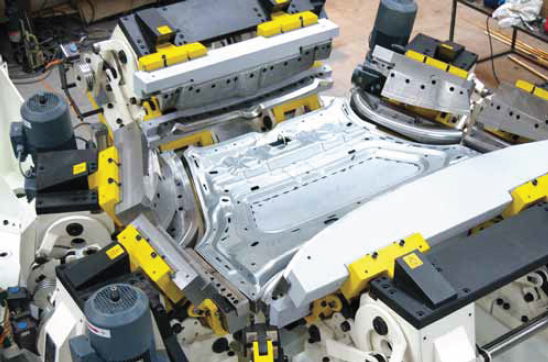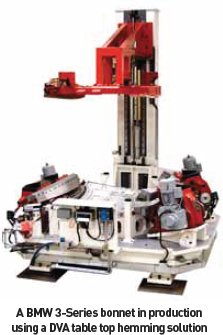
DV Automation is both an equipment supplier and contract manufacturer serving various OEMs
DVA is, together with Thompson Friction Welding, a subsidiary of Kuka AG. While the company also carries out contract manufacturing, for example delivering axles to Land Rover and piston cylinders to JCB, DVA’s core business is designing and implementing closure hemming solutions to join the inner and outer panels of doors, boots and bonnets. Mark Schlanker, Business Manager at DVA, explains the various equipment types. “There are three main types of hemming installations. Press hemming was the first technique used to complete the operation and its been around for a long time. Then came table top hemming machines. ‘Table top’ refers to the fact that the machine rests on a stand-alone base with the required auxiliary units mounted on the table in order to complete the hemming operation. A direct development from table top was roller hemming, which has become very popular over the last 10 years, but we have recently seen a move back towards table top.”
Although roller hemming has its limitations, it is a favourable solution in terms of cost. Schlanker: “The carmaker will have an agreement with a robot supplier, who will provide robots to the company building the line. Buying perhaps 1,000 robots at a time, they get a very good price. These can be used as part of a roller hemming solution, which make it a very cheap solution. A standard part, the robots are 99.9% reliable, essentially fit and forget. The equipment is also usually simpler. There is an understeel, like a table top machine, but there’s no hemming beams and form steels.”
On a table top machine, the form steels fold over the flange in a single action performed in one long run. On the other hand, roller hemming is based on point contact, completing only a portion of the process with each pass, explains Schlanker. “The roller tool is simplified and the hem process is longer.” Despite this, he says that roller hemming, initially used for low to medium volumes, is now being used for vehicle production requiring higher cycle times, despite the need for additional hard tooling, corner hem units and prebend units. The cost and complexity of these add-ons could be another factor driving the renewed popularity of the table top solution, says Schlanker. “I think customers have had quality concerns (with roller hemming). Fiat only use table top hemming. Volkswagen uses both, but we have seen them going back to table top solutions.”
New solutions
While roller hemming may be losing favour in certain areas, it remains the hemming solution of choice in developing markets such as India, where a cost-effective process outweighs any related quality issues. Schlanker also notes that until recently, the volumes weren’t of the magnitude to require faster turnaround times.
 This looks set to change in the near future, but roller hemming technology is being updated to suit highervolume production. He adds that companies are turning to a combination of roller and table top hemming, while faster roller hemming heads are also under development. “We have a powered roller head solution. It’s an extension of the robot control system, classed as a 7-axis drive, with an AC servo motor driving the rollers. It’s driven and controlled by the robot, with the powered rollers pulling the metal through.” In addition to this, DVA is looking to further extend its range of table top hemming solutions with a more flexible version of the equipment. “Flexibility is key in automotive. We developed this system to give carmakers the ability to accommodate future models. With the commonality between different models, it can support production of a number of variants on one system, or add new parts as they come on stream. It’s still a table top system, but it has a separate hemming tool positioned on top, which can be switched out to process parts for different models.”
This looks set to change in the near future, but roller hemming technology is being updated to suit highervolume production. He adds that companies are turning to a combination of roller and table top hemming, while faster roller hemming heads are also under development. “We have a powered roller head solution. It’s an extension of the robot control system, classed as a 7-axis drive, with an AC servo motor driving the rollers. It’s driven and controlled by the robot, with the powered rollers pulling the metal through.” In addition to this, DVA is looking to further extend its range of table top hemming solutions with a more flexible version of the equipment. “Flexibility is key in automotive. We developed this system to give carmakers the ability to accommodate future models. With the commonality between different models, it can support production of a number of variants on one system, or add new parts as they come on stream. It’s still a table top system, but it has a separate hemming tool positioned on top, which can be switched out to process parts for different models.”
Schlanker explains that the hemming unit comprises what is best described as an exchangeable tool pack, with the tooling an integral part of each unit. The tool can be changed either ‘in process’ or at a later date, making it semi-permanent, whichever best fits the carmaker’s requirements. The part-specific tool is developed by DVA, according to the carmaker’s requirements. The unit features a machined and fabricated base, with cast understeels supporting the clamping system. With a sliding, load-unload transfer system, new tooling can be installed in as little as six seconds. A shot bolt system automatically fixes the new tooling in place. Obviously, a bonnet is a much bigger part than a door. Can a single machine hem both parts, or does size dictate using two separate machines?
“If you have a larger machine, it can accommodate smaller parts,” says Schlanker. “A larger machine will require a higher investment. If you’re making a normal bonnet and one for a Bentley, then you’re going to struggle, but we can design a machine to suit larger parts.” He continues by pointing out that for this type of automated equipment, DVA needs to create a specific hemming solution to suit the needs of the end user. “These units are standalone parts of the line, so setup will be influenced by a number of factors, including how the line is fed. You can make left- and right-hand doors, but that only works if the lines run together. It comes down to line setup and cycle times.”
Getting it done
Hemming could be described as an operation that delivers more than the sum of its parts. Mark Schlanker explains: “Each of these closures has an inner and outer layer. The outer has the flange that is folded over to join the two parts. In addition to this, it’s a cosmetic operation. For a safety edge or for an improved finish on say aluminium, we use a ‘rope’ hem, rather than a ‘flat’ hem for joining bonnet panels.” He continues by saying that there is usually a bonding agent or adhesive involved with the profile join. Depending on the material and the sealant used, this can be applied to one or both of the parts. Adhesive application can be performed in the hemming cell, prior to ‘marrying’ the inner and outer parts, before loading into the table top. If the adhesive application process is automated, Schlanker says that it is preferable to move the part around a static dispenser, as this avoids issues with the robotic harness. If a flat hem is being used, often an adhesive with an integral media is used, usually glass beads. This helps to maintain the gap, instead of the adhesive being squeezed out as the hemming operation is performed.
Whether using a specific curing process, or a self-curing adhesive, there is potential for the two joined parts to slip post hemming process. To counter this, DVA has developed an integrated welding solution that applies a number of single-sided spot welds to hold the panel together as it is moved. While the process is not new, the integration of the welding process to the hemming machine is new for hemming operations.
“It’s not so much of a problem with panels that have a lot of shape to them, as the profile of the panels will lock the two parts together, but a flat panel can demonstrate a tendency for the inner and outer panels to move against each other,” says Schlanker. Typically, this welding process applies between six and eight spot welds to hold the part together, equally divided over the part. The welding heads are supplied from a range of specialist welding companies. “Primarily we use Kuka robots, but being customer driven, we have the ability to work with other robot suppliers,” he points out.
Machine life
In regards to the durability of the hemming heads, what can users expect? “The rollers are classed as a consumable,” says Schlanker. “There are different rolling materials and cleaning processes; rollers tend to pick up dirt or material (when used on aluminium). It largely depends on the worked material. The rollers are made from hardened material to extend their working life.”
The sealed rollers in the head unit are lubricated for the lifetime of that assembly. Yet most materials, steel or aluminium, have a light coating of lubrication as a residue from the press or stamping process. Does this affect performance of the hemming heads? “It’s better to have clean parts, but it’s not as critical as in other operations, such as welding. We are not aware of any problems with excessive lubrication affecting head performance.”
Table top machines can cost up to



































